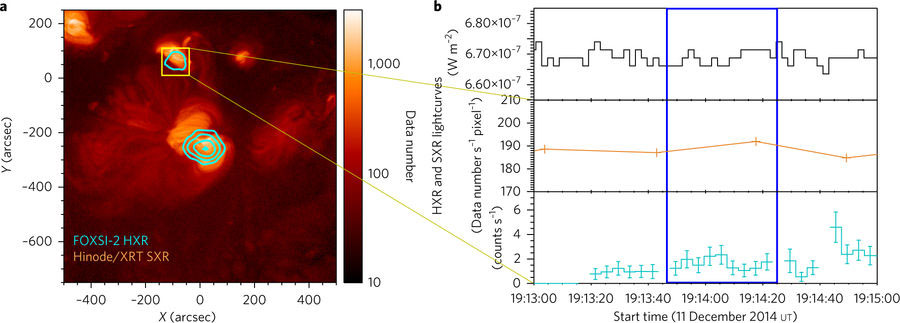太陽コロナにおけるナノフレアにより加熱されるプラズマのFOXSI-2観測ロケットによる検出
Detection of nanoflare-heated plasma in the solar corona by the FOXSI-2 sounding rocket
2017年10月9日 Nature Astronomy 1 : 771 doi: 10.1038/s41550-017-0269-z

太陽や恒星のコロナを数百万ケルビンにまで加熱する過程は、はるかに低温の光球(太陽で5,800ケルビン)に比べ、いまだによくわかっていない。一つの提案されたメカニズムは、ナノフレアと呼ばれる、多数の小さな解像されていないインパルシブ型の加熱現象を通じたものである。それぞれの現象は速やかに加熱、冷却され、平均的な効果は、少量の極めて高温のプラズマを含む、広い範囲の温度をとり得る。しかし、これらの暗い高温の痕跡を、さらに明るく低温の放射の中に検出することは観測的に困難だった。本論文では、太陽X線観測ロケット(FOXSI-2)の2回目の観測飛行により、個々のX線フレア放射を明瞭には示さない太陽の活動領域から7キロエレクトロンボルトを上回る放射を検出し、硬X線データを得たことを報告する。我々は、微分放射測度DEM(differential emission measure)計算から、この放射が1,000万ケルビン以上に加熱されたプラズマの原因であると考え、このことから太陽ナノフレアの存在の証拠が得られる。高温プラズマの定量的評価は、コロナ加熱のモデルを強く制約する。
Corresponding Author
The processes that heat the solar and stellar coronae to several million kelvins, compared with the much cooler photosphere (5,800 K for the Sun), are still not well known1. One proposed mechanism is heating via a large number of small, unresolved, impulsive heating events called nanoflares2. Each event would heat and cool quickly, and the average effect would be a broad range of temperatures including a small amount of extremely hot plasma. However, detecting these faint, hot traces in the presence of brighter, cooler emission is observationally challenging. Here we present hard X-ray data from the second flight of the Focusing Optics X-ray Solar Imager (FOXSI-2), which detected emission above 7 keV from an active region of the Sun with no obvious individual X-ray flare emission. Through differential emission measure computations, we ascribe this emission to plasma heated above 10 MK, providing evidence for the existence of solar nanoflares. The quantitative evaluation of the hot plasma strongly constrains the coronal heating models.

